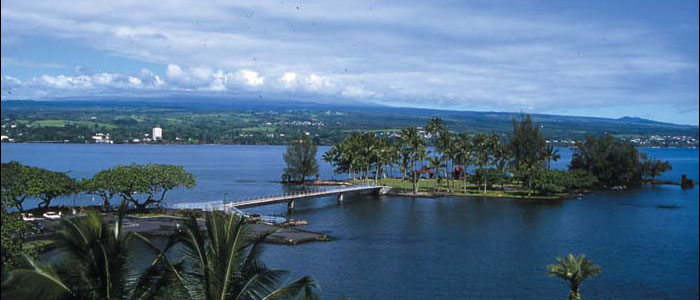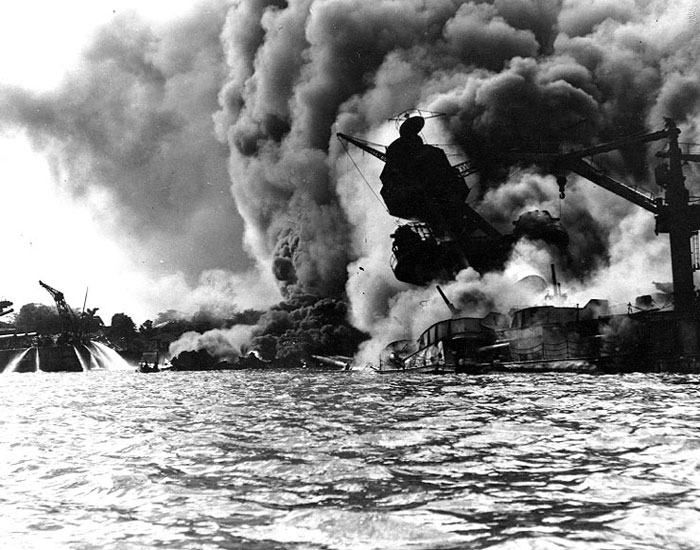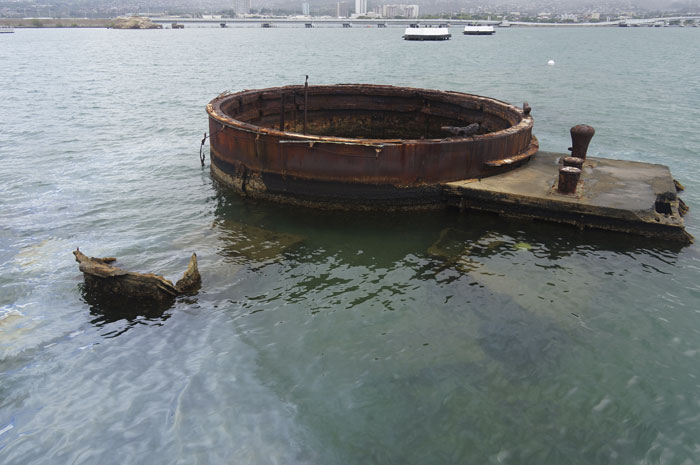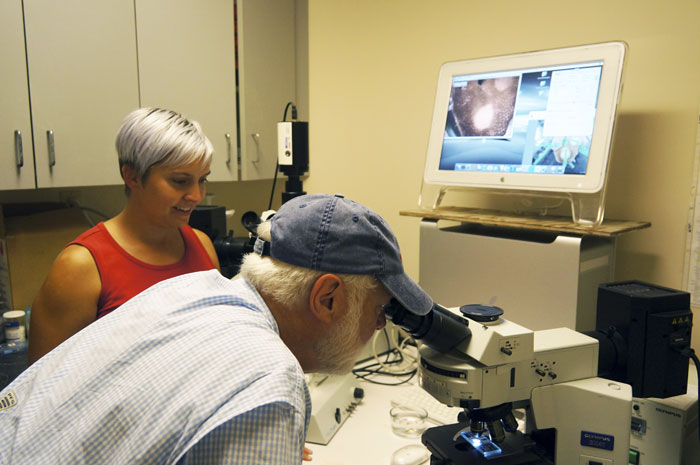On the road in Hawaii IV: The Secretary’s travel journal
The final day in Hawaii is both a somber reminder of the fragility of life and an inspiring look at nature’s determination to create it. Learn more about the Smithsonian’s long history in Hawaii in Part One, study the stars in Part Two and explore the ecology of the coral reef in Part Three of the Secretary’s Hawaiian travel journal.
Sunday Morning, September 2, mid-70s, light breezes and clouds with intermittent rain showers
Today will be split between a morning visit to Pearl Harbor and the adjoining Pacific Aviation Museum and an afternoon visit to Coconut Island where we will learn more about Mary’s research and hope to see an actual coral spawn.
We arrive at Pearl Harbor, which today is both an active naval base and home to the World War II Valor in the Pacific National Monument and the famed Battleship Arizona Memorial. The monument and memorial tell the story of the Japanese air and submarine attack on Pearl Harbor on December 7, 1941—the terrible toll that was taken and the courage of the soldiers, sailors and Marines under attack. After many years of alternate approaches, the Park Service recently created a new open monument center that invites visitors to walk through and around interpretive stops and displays. A thoughtful film helps visitors appreciate the events leading up to and following the attack.
Torpedo planes attack “Battleship Row” at about 8:00 a.m. on December 7, seen from a Japanese aircraft. Ships are, from lower left to right: Nevada with flag raised at stern; Arizona with Vestal outboard; Tennessee with West Virginia outboard; Maryland with Oklahoma outboard; Neosho and California. West Virginia, Oklahoma and California have been torpedoed, as marked by ripples and spreading oil, and the first two are listing to port. White smoke in the distance is from Hickam Field. Grey smoke in the center middle distance is from the torpedoed USS Helena, at the Navy Yard’s 1010 dock. Japanese writing in lower right states that the image was reproduced by authorization of the Navy Ministry. (Image via Naval History and Heritage Command)
The precisely timed attacks came in two waves and focused on destruction of the United States’ Pacific fleet and airplanes. The fleet had been recently moved to Pearl Harbor as a precaution since negotiations with Japan about their warlike intentions had deteriorated. Once at Pearl Harbor, the Navy commander concentrated the ships inside the seemingly protected confines of the harbor. Airplanes were likewise carefully lined in rows near the runways so they could be more easily protected from the threat of sabotage. Massed as they were, the fleet and the aircraft presented perfect targets for an air attack. Ironically, radar, a new technology designed to detect incoming aircraft, did spot the incoming Japanese planes, but the operator assumed what he saw was simply the arrival of an expected contingent of American warplanes arriving in Pearl Harbor.The devastation of the American fleet and the aircraft is well documented. Three factors did help mitigate the losses from the attack. First, the American aircraft carriers were at sea and escaped destruction. Second, even though many of the ships in the harbor were damaged, cool-headed commanders saw to it that many were moved to shallow waters where they could be later refloated and repaired. Finally, the Japanese decided to call off a third wave of the attack that would have destroyed the infrastructure and fueling stations at Pearl Harbor. Many naval commanders felt this last phase would have been more far more difficult to recover from than the damages to the fleet and warplanes.
-
USS Arizona sunk and burning furiously, December 7, 1941. Her forward magazines had exploded when she was hit by a Japanese bomb. At left, men on the stern of USS Tennessee are playing fire hoses on the water to force burning oil away from their ship (Official U.S. Navy photograph, National Archives collection)
At the end of the day, 2,400 sailors, airmen, soldiers and Marines were killed during the attack. Of these, 1,177 were on the World War I battleship USS Arizona, which was hit by a high-altitude bomb that exploded her forward magazine in the blink of an eye. The memorial to the lost men of the Arizona is a marble structure designed by architect Alfred Preis that lies above the hulk of the battleship resting on the bottom of the harbor in shallow waters and the crewmen who are entombed there. Preis, an Austrian by birth who was held in detention at the outbreak of the war, was asked to design the memorial in the shape of a “bridge,” which to the naval commanders meant a ship’s bridge. Instead, he conceived it as a literal bridge that dipped in the middle and rose toward the ends. The center of the bridge symbolizes the terrible loss and lies directly over the Arizona. The uplifted ends of the bridge are meant to suggest how we have risen above the tragedy.
A Navy vessel takes visitors from the visitors’ center to the Arizona Memorial in the harbor. Johnny and I are among the 4,000 or so visitors who will make the trip today. We are accompanied by Burl Richardson, a curator and historian for the Pacific Aviation Museum, who is an expert on Pearl Harbor and the Japanese attack. Burl fills us in on remarkable details about the events December 7 and the history of the USS Arizona. When we arrive at the memorial, the crowds are hushed out of respect for the seamen entombed below. Oil still seeps from the hulk of the battleship, discoloring the water above. The names of those who died during the attack are listed on a wall; two marble benches stand in front of the wall and list the names of the Arizona crew who survived the attack but have since passed on. The experience at the memorial is so moving we are still subdued after returning to shore.
Our next stop is Pacific Aviation Museum on Ford Island, part of the Pearl Harbor Naval Base, where we are joined by Ken DeHoff, the museum’s executive director, and Chief of Operations Scotty Scott. Scotty begins our tour by driving us around the island so we can get the lay of the land and understand the locations of the buildings and airfields on the island as they were at the time of the attack on Pearl Harbor. Bullet trails can still be seen on the concrete aprons where Japanese aircraft strafed the airfield and destroyed planes that were on the ground. Windows in the hangar that is used today by the museum to restore aircraft clearly show bullet holes from the attack. Ford Island is mainly used by the Navy for housing and administration and has a park-like feel.
The museum will celebrate its sixth anniversary on December 6 of this year. It has come a long way in a short time, with an outstanding collection of restored World War II aircraft, some of which are found only here. The collection is being expanded to include aircraft used in other campaigns and conflicts after World War II. The control tower is being restored and soon will be open to the public.
The museum has a strong outreach and education program led by Shauna Tonkin. Innovative math and science lesson plans are built into the use of aircraft simulators and computer games that allow students to compete as well as work on their own. Programs for teachers and students alike are also delivered online.
We are proud that the museum has become the latest member of our Smithsonian Affiliations program. A number of the 176 member institutions are air and space museums and we have common interests through our own National Air and Space Museum on the Mall and its Udvar-Hazy Center at Dulles Airport. We look forward to working with the Pacific Aviation Museum as it continues to grow and reach larger audiences.
Sunday afternoon, September 2, warm, light intermittent showers
Sunday afternoon we visit Moku O Loe, more commonly known as Coconut Island, home to the University of Hawaii’s Institute of Marine Biology. Coconut Island lies not far from shore in Kaneohe Bay just to the west of Kaneohe Station, a large Marine Corps operations base. Thanks to collaboration with the Institute, Mary has access to facilities on Coconut Island for her research; this evening she assures us that we are going to see a coral spawn, the process used by coral polyps to reproduce.
Coconut Island has a colorful history, having served as a retreat for Hawaiian royalty in the 1800s and more recently, as the background for the opening scene of the TV comedy, “Gilligan’s Island.” In the 1930s, the island was bought by Christian Holmes, heir to the Fleishman family fortune, who built a tuna-packing plant and an estate with handsomely groomed grounds. Over the years, he added to the island by dredging sand and coral from the surrounding bay; today it is about 28 acres. Interestingly, one of his groundskeepers was almost the first casualty of the Japanese attack on Pearl Harbor. The first wave of planes flew directly over Coconut Island, and when pilots spotted the groundskeeper running for cover, he was strafed to keep him from reporting what he had seen. Fortunately, he survived, but unfortunately, did not report this first sighting of the Japanese planes.
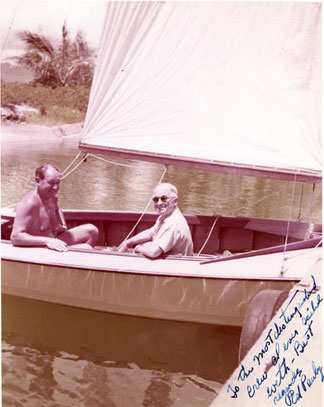
Edwin Pauley (left) and former President Harry S. Truman (right) in a sailboat during Truman's visit to Pauley's estate in 1953. (Image via Harry S Truman Library and Museum)
California oilman Edwin Pauley bought the island after Holmes died, apparently with the intention of building a resort there. He made some restorations but never built the resort. One of his notable guests was First Lady Jacqueline Kennedy, who stayed on the island after President Kennedy’s assassination in 1963. Eventually, with the help of Mr. Pauley, the University of Hawaii acquired the island for its Marine Biology program.
Mary introduces us to Jo-Ann Leong, director of the Institute, and we take a University boat out to the island. UH students get free room on the island in return for running the boat shuttle for visitors. Not a bad deal!
We first tour the facilities via a golf cart skillfully maneuvered by Jo-Ann. We get an overview of the research capabilities on the island and see the remnants of Christian Holmes’s estate, including a beautiful saltwater pool excavated into the coral reef on the west side of the island. Portions of Holmes’ home have been incorporated into one of the new laboratory buildings.
Mary introduces us to her colleagues as she takes us through her own laboratory facilities. The first stop is an older lab that houses her collection of zebra fish. Mary is working with colleagues in Natural History in Fish Division and Collections to learn to freeze the stem cells of fish testes that may be added to the collections during MarineGEO. The preservation of these cells can help recreate a species, because they can be placed into a sterile host fish and the cells will produce sperm and eggs of the donor- which could be extinct! She is applying her techniques for collecting and cryogenically storing reproductive tissue from the zebra fish for later reproduction. Zebra fish are used around the world to study human diseases because their DNA is remarkable similar to that of humans and their short life span allows progression of diseases to be observed over short time frames. They are replacing the more commonly used white mice for research because the fish are easier to care for and have shorter life spans. If Mary and her colleagues can perfect the cryopreservation for zebra fish stem cells, this will be an important step for how the Smithsonian stores its fish collections. SI will be the first museum in the world to have frozen, live collections in addition to its more traditional holdings. It is always interesting to see that significant science can occur in modest facilities.

The Zebrafish (Danio rerio) is a tropical fish belonging to the minnow family (Cyprinidae). It is a popular aquarium fish and an important model organism. (Image via RedOrbit.com)
In more modern facilities up the hill we are escorted through the coral labs. Coral reefs thrive in shallow tropical ocean waters that are cleaned by the agitating action of tides and waves. Coral polyps live inside a hard carbonate skeleton along with symbiotic algae, and both must be healthy for the reef itself to survive. Although their exoskeleton gives them the appearance of durability and resilience, as living creatures with a dependence on symbiotic relationships with other animals, coral polyps are sensitive to temperature and water quality changes.
In addition to freezing and storing coral sperm and larval cells, Mary’s group is trying to cryopreserve different types of coral tissues, such as small coral fragments, and other reef-related organisms. Mary’s associate, Ginnie Carter, who has worked with her for seven years, uses a microscope to show us a small segment of living coral that shows the openings in the carbonate structure where the polyps live and the moving tentacles that extend into the water to catch food particles that float by. They use this microscope to determine whether the coral fragment is alive after cryopreservation trials. Another set of lab benches holds the tools for cryogenically storing coral sperm, and we use microscopes to see how stored sperm combines with eggs to produce larvae in about a day’s time. Nik Zuchowicz, an intern from Carlton University in Canada, demonstrates a new freezing device he designed that allows sperm to freeze uniformly and can be made easily and cheaply in developing countries. If maintained in a frozen state, the sperm will remain viable for potentially thousands of years. Mary’s specimens are stored at a National Animal Germplasm Program in Colorado through an agreement with the U.S. Department of Agriculture.
From Mary’s labs we move to others where Institute personnel are conducting experiments and investigations on different aspects of coral and marine life. We meet Greta Aeby, an expert in coral disease who shows us pictures demonstrating how various diseases are becoming more prevalent in Hawaii reefs, including algae death and bleaching due to warming ocean temperatures or loss of sunlight from silt or pollution. Coral are also susceptible to the growth of tumors and certain form of cancers but the cause is not yet understood. It is clear that the reefs are under stress and there is growing concern that the loss of the reefs could accelerate. In a related study we see an experiment examining the impact of increasing levels of carbon on coral reefs. Carbon is beginning to change the chemistry of ocean waters and thus will impact corals, but the extent and rate of the impact is not known. The investigation will help us anticipate what will happen to the reefs as carbon builds up in our atmosphere.
Finally it is time for us to walk to the island point where we will see the coral spawn. On the way, we cross over a large pool where Institute personnel are studying shark behavior and, as if on cue, we see several prehistoric-looking hammerheads and several larger white-tipped reef sharks.
Mike Henley joins us at the lab where a large number of shallow glass containers contain coral specimens submerged in salt water. If nature follows form, we should see the coral spawn, and Mary and Mike assure us the timing is remarkably predictable. Coral time the spawn based on the lunar cycle and are able to perceive the right time based on visual signals using proteins within their cells that sense changes in light (similar to those in our eyes!). Mary says we should expect to see the action begin around 10 or 15 minutes after six o’clock.
As we wait, we learn more about coral behavior from Erika Johnston, who is another intern in Mary’s lab. Her experiment takes place in a large container of salt water with a series of small clay tiles lying along the bottom. She is seeking to understand the process whereby algae trigger coral larvae to settle and begin to build a reef. These so-called, crustose coralline algae are critical to the life on the reef because they release chemical cues that tell coral larvae where to settle. They consist of fragile carbonate structures that are being eroded by ocean acidification. Mary’s group is trying to cryopreserve these important organisms before they disappear.
With time before the spawn begins, Mary and her colleagues treat us to a wonderful dinner with a number of home prepared salads while we enjoy an expansive view of the bay and its beauty. I enjoy talking with the students and am reminded of the wonderful experiences I have had in mentoring graduate students in their research.

Eggs resembling fine grains of sand are emitted into the water as the coral spawn. (Photo by John Gibbons)
Promptly at ten after six we head back to the coral specimen tables. Nothing seems to be happening, but Mary is unconcerned, and sure enough, the mouth of one of the corals opens and emits a milky stream into the water. Soon, other specimens follow suit, sending streams of either eggs or sperm into the water. Although I could not tell the difference, the coral experts around the table are able to identify whether the coral has emitted eggs or sperm, and they explain that coral can change sexes between spawning cycles so that a female today may be a male the next time around. In the ocean, the coral spawn is often called a “bloom” because the sperm and eggs are ejected so profusely they can look like an upside-down snow storm. The bloom attracts fish by the thousands who feed on the protein-laden eggs and sperm, and they, in turn, attract other predators such as turtles who feed on the fish. It is truly one of nature’s unique spectacles.
I feel privileged to have not only seen coral spawn, but also to have been able to do so in the company of some of the world’s most knowledgeable coral experts. With seven o’clock approaching we must return to hotel to prepare for our return to Washington. I am grateful to Mary, Mike, Jo-Ann and all of the students and researchers who were willing to take time from their Sunday to help us understand the value of Coconut Island to marine science and to appreciate the amazing life of corals. I am reminded yet again how nature’s complex and ever-connected web sustains life on this planet. We humans are changing our world without a full appreciation of how it works. This we do at our own peril and it makes it all the more important for organizations like the Smithsonian to conduct research to understand our impact and to find the means to sustain life before we destroy it.
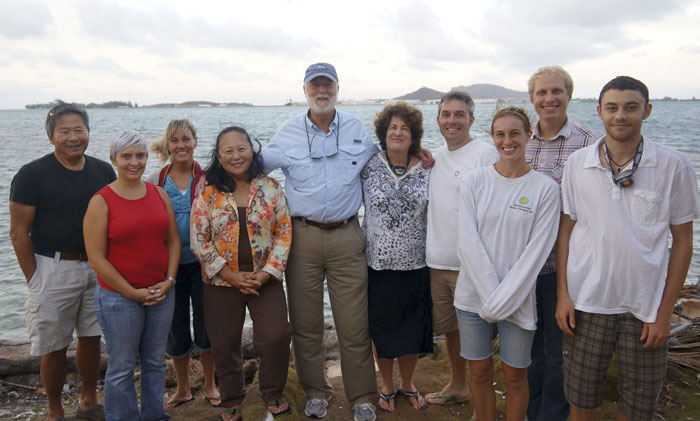
From left, Oren Leong, Ginnie Carter, Greta Aebey, Jo-Ann Leong, Wayne Clough, Mary Hagedorn, Mike Henley, Ericka Johnston, Nik Zuchowicz and Micaiah Phillips (Photo by John Gibbons)
Posted: 25 September 2012
- Categories:
